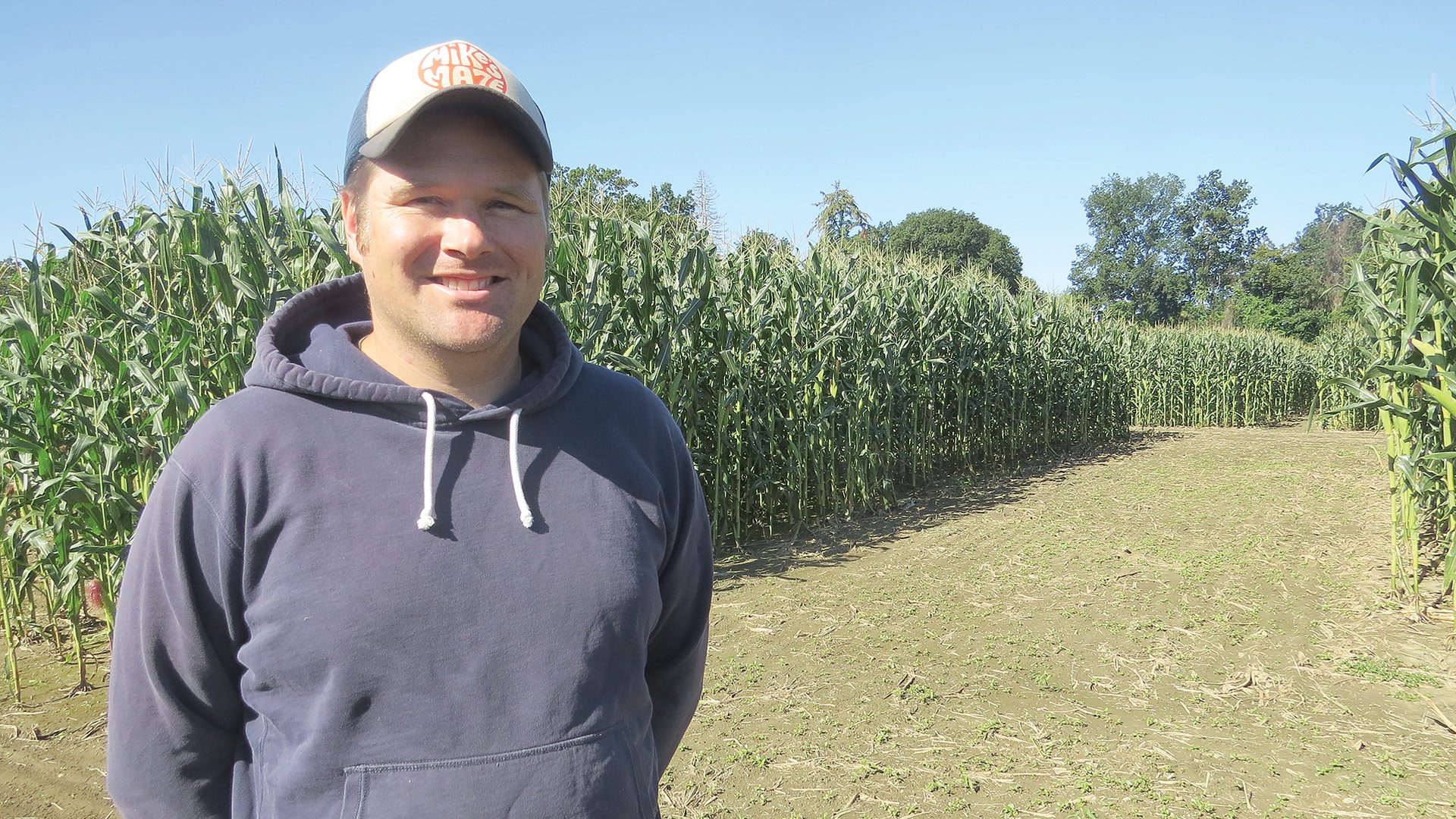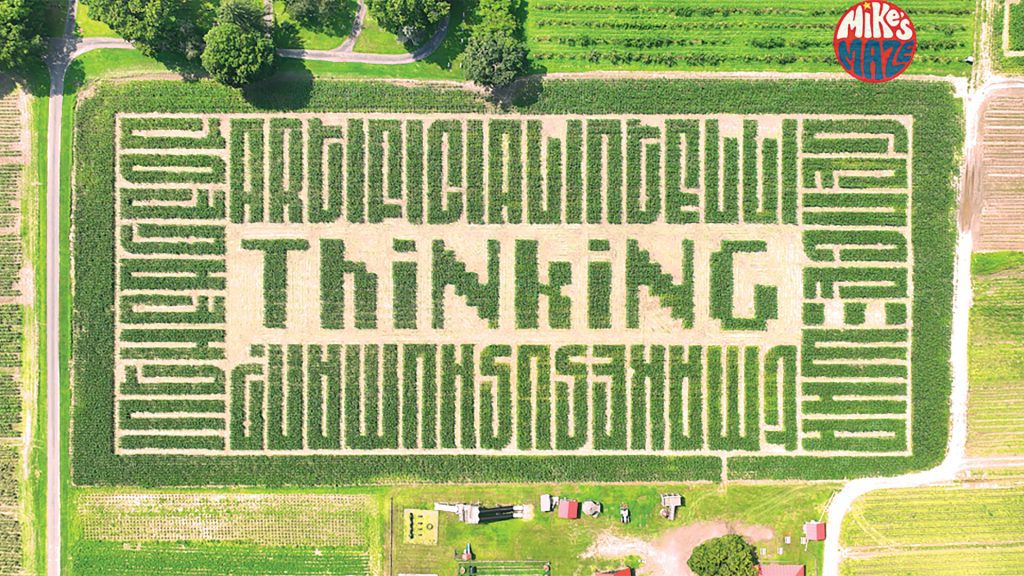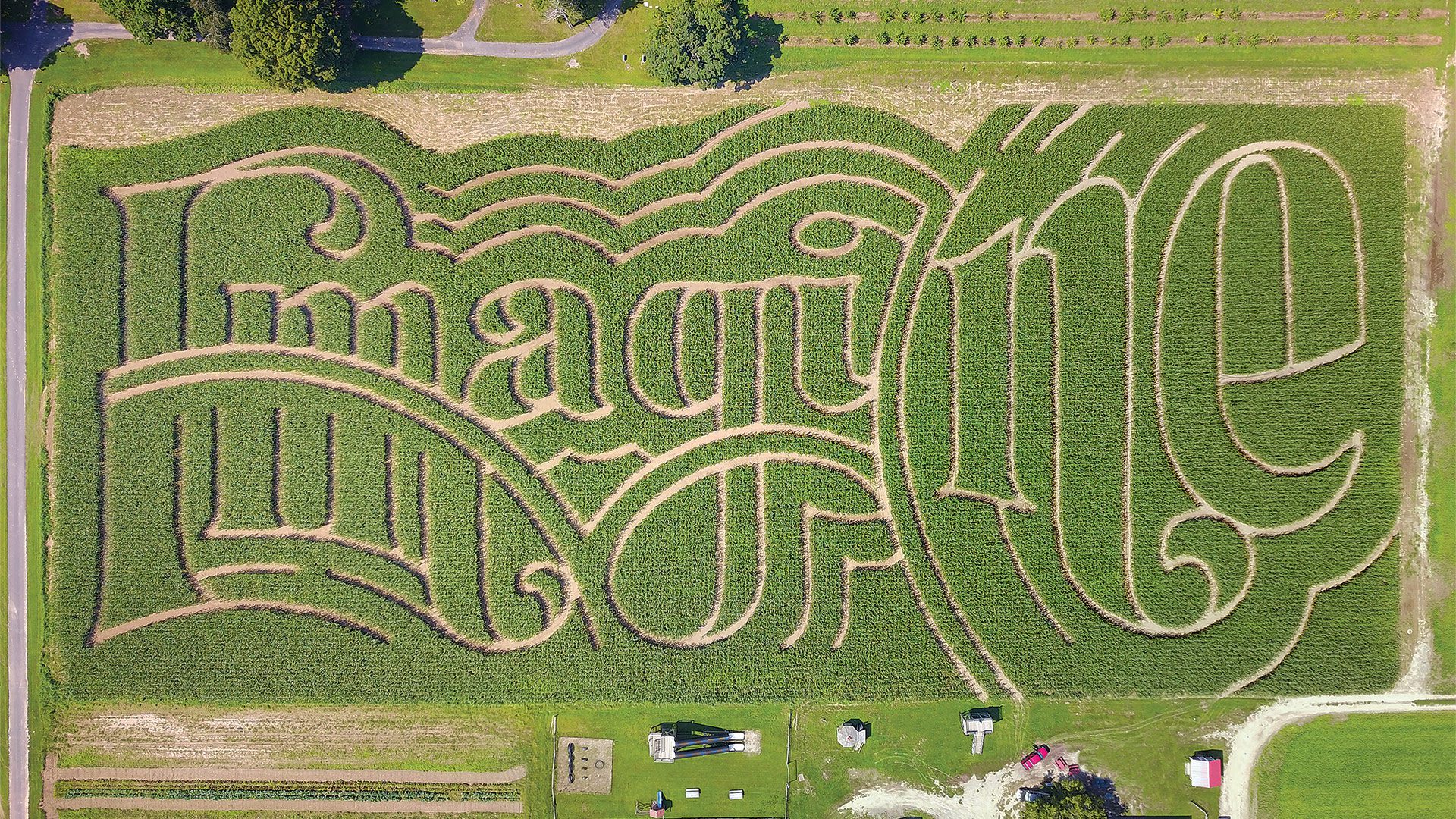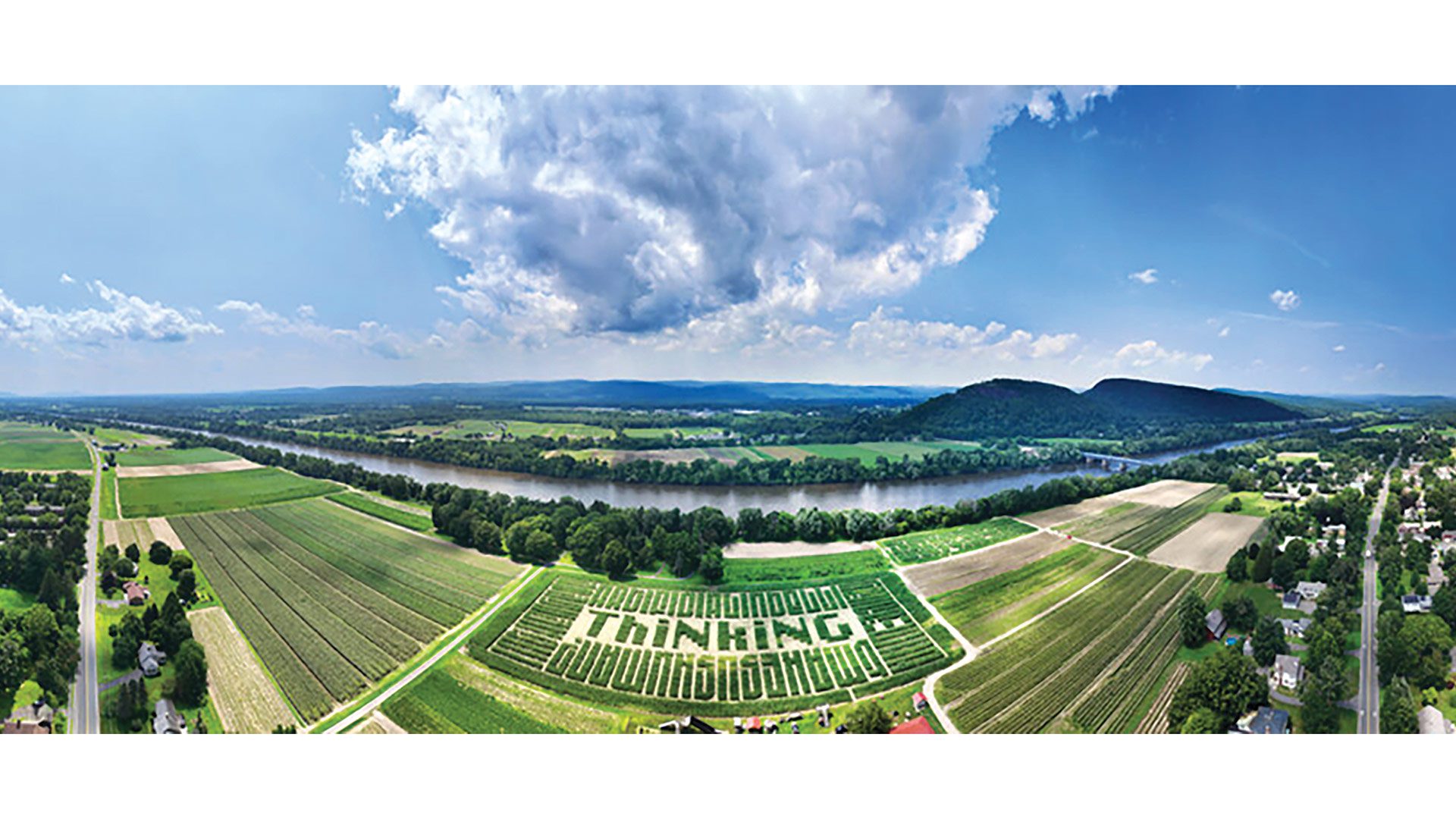
At Mike’s Maze, Visitors Can Take In the Big Picture
We’re All Ears

Dave Wisseman says this year’s maze is designed to get people thinking about AI and all its implications.

“Where art and agriculture come together.”
That’s how Dave Wisseman, the soon-to-be 10th-generation owner of Warner Farm in Sunderland, described the famous corn maze that has put this operation on the map.
And he’s right. The designs that are cut by a Bobcat into the 10 acres of feed corn growing on one field at this gorgeous piece of land in the shadow of Mt. Sugarloaf certainly constitute art — whether the resulting image is of Babe Ruth, the Mona Lisa, an homage to the country’s national parks, or this year’s creation: a nod, if one can call it that, to artificial intelligence.
Or at least the discussion about AI.
But there is more coming together with agriculture than art at what has become an institution in Western Mass. and a destination that draws people from the 413 and well beyond. Indeed, there are also large doses of tourism, entertainment, innovation, inspiration, culture, and education.
And a whole lot of entrepreneurship.
They all collide at the maze, which started its annual run on Sept. 8, but has been in the planning stages for several months now, said Wisseman, who acknowledged that farms are not big on titles, but if he had one, it would be ‘business manager.’
In that role, he noted that the maze has become more than a revenue stream, although it is certainly that. It has become a huge part of the business plan at the 150-acre farm, which grows a variety of fruits and vegetables and operates CSA (community-supported agriculture) programs in Sunderland with five pick-up areas in the Greater Boston area — so much so that many other traditional fall initiatives, and the feed-corn crop itself, now take a back seat to the maze.
“For us, the corn maze is such a huge part of our business that it made sense to slow down the other things in the fall and focus on making sure the maze is the best it can be.”
“For us, the corn maze is such a huge part of our business that it made sense to slow down the other things in the fall and focus on making sure the maze is the best it can be,” he said, noting that the attraction draws more than 20,000 visitors each year, most from Hampden and Hampshire counties, but neighboring states as well. Many leaf peepers have made it part of their annual visit.
As for the images chosen each year, they are part of the evolving story of the maze, said Wisseman, noting that his father, Mike Wisseman, and local artist Will Sillin originally decided to combine talents and create what they called ‘corn art.’ The inaugural image was of the ‘Amazing Minuteman,’ as seen on the 2000 Massachusetts quarter, with subsequent designs featuring the Mona Lisa, Babe Ruth, King Tut, George Bush and John Kerry (who squared off in the presidential election of 2004), Charles Darwin, Andy Warhol’s Campbell’s soup can, and Julia Child — images seen by the world through photos taken by passing airplanes.
In 2015, Sillin essentially retired from corn art to focus on his personal artwork, and the creative development torch at what became known as Mike’s Maze was picked up by Dave Wisseman and his wife, Jess Marsh Wisseman, also an artist.
Her creations have included ‘Alice in Sunderland,’ a tribute to Alice in Wonderland; ‘Greetings from Earth,’ a celebration of the Voyager missions to explore the outer reaches of our solar system; and ‘Cornstock,’ a celebration of Woodstock a half-century after the generation-defining music event — images captured by drone and then sent to the world.

‘Greetings from Earth’ is one the many works of art etched into cornfields at Warner Farm over the past two decades.
Photo courtesy of Mikes Maze
Getting back to this year’s theme of artificial intelligence, it exemplifies the farm’s efforts to be topical and relevant, but also go well beyond creating art in the rows of now-10-foot-high corn stalks. The larger mission is to get people to think, while also being entertained, Dave said.
Etched around the outside of the maze is the question ‘In the Age of Artificial Intelligence, What Makes Us Human?’ In the middle is the word ‘Thinking.’ The letters take on a high-tech look.
“We’re posing that question out in the maze and inviting people to answer it,” he said. “There’s a trivia game all about the different elements of artificial intelligence and robotics, and we’ll have a kids’ game, where they’ll use binary language to decode a secret message. And there will be a few stations out there where we pose some more of the deeper ethical questions about AI and ask people to consider them.
“‘Can computers think?’ That’s one of the questions we ask,” he went on, adding that the maze is designed to prompt visitors to think about technology and its place in the world.
For this issue, BusinessWest visited Warner Farm and this year’s maze to learn about how this has become much more than a place where art and agriculture come together.
Kernels of Wisdom
Tracing the history of the farm, Wisseman said it dates back to the early 1700s, when Eleaser Warner — a descendent of the family who arrived not long after the Mayflower and eventually settled in what was then called Swampfield, now Sunderland — started tilling land near what is now the center of town. (Indeed, the farm’s mailing address is South Main Street).
This is his mother’s family and and one of the founding families of Sunderland, he said, adding that, in the beginning, it was subsistence farming, and it remained that way for several generations. Over time, the farm started growing and selling potatoes, onions, and, later, strawberries.
“In the ’60s, my grandfather was introduced to the concept of pick-your-own strawberries, and we were one of the first people to do pick-your-own strawberries in the Valley, and it really took off,” Wisseman noted. “That was the first venture into the agri-tourism world and inviting people down to the farm to have that farm experience.”
Today, the farm’s main crops are strawberries and sweet corn, but it also grows tomatoes, melons, peas, green beans, peaches, and “a few apples,” he said. It sells wholesale to local stores, other farms, and other CSAs, while operating its own CSAs, including the Millstown Farm Market.
Wisseman said he grew up on the farm until he was 10, when he and his mother relocated to the Cincinnati area, and he would return to the area to work on the farm while in high school and college. He graduated from the College of Worcester in Ohio with no real intention of making the farm his career, but … his commencement coincided with the start of the Great Recession in 2008.
“In the ’60s, my grandfather was introduced to the concept of pick-your-own strawberries, and we were one of the first people to do pick-your-own strawberries in the Valley, and it really took off. That was the first venture into the agri-tourism world and inviting people down to the farm to have that farm experience.”
With few other opportunities available, he came back to the farm to work beside his father in 2010, and together they have continued and refined the many aspects of the operation, including the corn maze, which represents a dramatic (in every sense of that word) and evolving leap forward in agri-tourism.
The concept was born at a Christmas party, he said, when his father and his friend, Sillin, decided to combine their talents. The rest is history in the making.
As noted earlier, the maze has evolved over the years and in a number of ways, from the addition of elements within the maze designed to make people laugh and learn to the diversification several years ago into a separate ‘haunted’ cornfield, featuring a number of attractions, such as an ‘executioner’s chamber,’ designed to entertain and frighten those who enter.

The corn maze at Warner Farm has become a fall institution, where visitors can see art and agriculture come together in a powerful way.
Photo courtesy of Mikes Maze
The haunted maze and an accompanying Zombie Night Patrol, while both solid additions, were also heavy with overhead, said Wisseman, adding that they were eventually discontinued, with efforts focused on the corn maze and creating an experience for those who visit it.
That experience includes a large playground featuring a drain-tube slide, a tractor-tire jungle gym, and more, as well as horse-drawn wagons, potato cannons, picking out a Halloween pumpkin, and other activities.
Meanwhile, the farm has created what it calls ‘beer mazes’ in a separate cornfield; six brewers — different ones each week — will set up stations in the maze, Wisseman explained. “It’s a brewfest in a cornfield.”
Art and Soul
The corn maze and related activities have become so popular, and such a large part of the business plan, that the farm essentially puts its full focus on that operation in the fall, Wisseman said, adding quickly that planning and execution begin months earlier.
It starts with the concept, he said, and much discussion about what the theme will be. Current events often play a role, as do round-number anniversaries, as was the case with the Woodstock theme. While other options were considered, the overwhelming amount of attention focused on AI eventually made it the logical choice for this year’s theme.
With the theme finalized, the next step is the design — in this case, the words, the font, and more — which was created by Jess Marsh Wisseman.
An Adobe file is then sent to Rob Stouffer, owner of Precision Mazes, a Missouri-based outfit that specializes in creating corn mazes. It has been handling the cutting at Warner Farm for several years now, and has a large image of the ‘Greetings from Earth’ design prominent on its website under ‘featured projects.’
Blending accurate GPS technology with advanced cornfield-cutting techniques, the company will transform a field into a message in just a few days, Wisseman said, adding that the work on this year’s maze was completed several weeks ago.
Walking through the maze, one will encounter some vast, wide-open spaces, especially where the word ‘Thinking’ has been etched, but the maze is a far more valuable revenue stream than the corn that was growing there, he said, adding that this acreage is set aside for feed corn, which is sold to other farms and also a few restaurants for the making of corn tortillas.
“We put a lot of thought into this. You want to dive into a topic, you want to make it fun and interesting, but we also like to challenge our visitors and prompt them to think about it a little bit.”
While not quite a year-round undertaking, the maze has become a huge part of this 300-year-old operation, Wisseman noted, adding that months are spent not only on the concept and design, but also the creation of learning opportunities within the maze — for children, but also people of all ages.
“We put a lot of thought into this,” he told BusinessWest. “You want to dive into a topic, you want to make it fun and interesting, but we also like to challenge our visitors and prompt them to think about it a little bit.”
Getting back to this year’s maze and the broad and now-controversial topic of AI, he said the farm isn’t making any kind of statement or forcing any opinions on visitors. Instead, it is inspiring them to think and create their own opinions.
“We’re saying, ‘hey, this is an issue that requires a little bit of thought,’” he said. “It’s easy to be like, ‘the robots are coming for us,’ but we want people to think about what computers can actually do for us; what is their greatest hope for the invention of AI and this technology? And what is their greatest fear?”
These sentiments explain what the maze has evolved into over the years. It is certainly art — the designs as seen from above are exquisite and captivating — but is so much more than that. It is now a destination and a tradition, as well as a huge part of a business that has survived for multiple generations through perseverance and entrepreneurship.
“It’s a big part of what we do,” Wisseman said in conclusion. “And it’s also just a lot of fun — it works a different part of the brain than the farming.”
The creative side.





